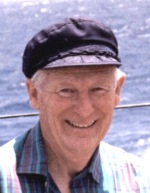

My Life at HP and Beyond, by John Borgsteadt
ForewordMr. HP Everyman—John BorgsteadtThis HP Memoir is ghost-written, by John Minck, with some help from Olive, his wife. But we assigned John B's name as author since most of the historical content herein has come from John's sharing significant events from his life, from his US Navy duty in the Guadalcanal combat, to his affection for mountain climbing or precision target shooting. Olive was also able to retrieve a number of documents from John's files, one of which was an HP instruction manual he had written for a Navy oscilloscope, the AN/USM-140B. It was really an HP 160 scope adapted for Navy use, with militarized parts and gunk that made it fungus-proof. We have referred to some of his other documents as content material. At various times, John recorded his adventures, such as the 1970 trip he took to the Galapagos Islands, He wrote about this in a report that was published in the HP Corporate Division newsletter, The Reporter. We also found John's own words in other documents, and which are provided as "Click References" in the following contents. I didn't know John during our common years at HP. I had heard his name, of course, and I knew that he worked in customer service, and was deeply involved in instruction manual writing. It was just in the last five years that I got to know him well, and that was caused by a random chance. There was an informal HP old-timer breakfast get-together by some HP associates, Bob DeVries, Larry Johnson, and John. They met every month, alternately at the Palo Alto Creamery or the Los Altos Pantry. Since Bob DeVries and I had worked on his HP memoir-in these archives-Bob invited me to join his small group for those informal meetings to rehash our times at HP and the hobbies and personal activities that were interesting. We came to enjoy those times together so much, we increased the breakfasts to twice a month. And a good time was had by all. Until unfortunately, Larry Johnson, and then Bob DeVries, died. We've added several more HP old timers to keep the breakfast conversations going, and to re-live more of those good work times at HP. Then, very recently, on Dec 6, 2015, John Borgsteadt died. John's stories at those breakfasts are how I got to know the real John B. For example, I learned that he was a precision target shooter. These are resolute people who buy EXPENSIVE target rifles, carefully size their ammunition cartridges, buy and measure the powder precisely, and visit their target range on days that have no wind. One breakfast date, John showed up with a US quarter with a 1/4 inch hole in the middle. He noted that he had used it at target shooting, and had hit it at 100 yards. But then he casually mentioned that THREE slugs had gone through the same hole! During those many breakfasts, all kinds of interests and hobbies and all of the HP career happenings were explored and enjoyed by all present. At the same time, I was assisting Curator Marc Mislanghe with his website for HP Memoirs. And all along the way, John's stories revealed just what an eventful life he had led. We heard of his US Navy WWII experiences, his personal connections with HP people like Fred Schroder, who ran HP Germany, his Navy League membership, and his Monterey Bay Aquarium volunteer work, which brought him on board a large Russian Marine research vessel, during its goodwill visit to Monterey. So, with the website in mind, I began my usual nagging, to encourage John to sit down with me and create his oral history. That didn't work. So I cooked up a template memoir, with as much as I could remember from his fascinating breakfast memories. I had hoped that once he saw I had gone part way, he would agree to sit for some talks to fill in the gaps. That didn't work either, and, unfortunately, before I could try again, he died. John's HP experience and all his hobbies and causes were much too good to lose. So I convinced his wife, Olive, to help me expand and compile more stories that only she would know about and remember. She found pictures and old documents, like his US Navy discharge certificate, and other artifacts that make this memoir a wonderful path through the life of the amazingly-purposeful John Borgsteadt. So we wrote and edited the content as if John himself were doing the writing. John Minck |
My Life at HP and Beyond, by John Borgsteadt
My Life at HP and Beyond, by John Borgsteadt
Part 1, The US Navy and Hewlett Packard
Growing up in San Francisco
I was born in St. Louis, MO, on Halloween Day, Oct. 31, 1920. I later learned that this was the beginning of boom times-The Roaring 20s-in the US economy, which lasted until the Great Depression, 10 years later. My dad was an architect and owned several US patents involving construction. My mother was a homemaker. Unfortunately my dad died when I was just a few years old. About 1923, my mother and I moved from St. Louis, and ended up in San Francisco, settling in the Sunset District. The Pacific Ocean and Golden Gate Park were both nearby. This location provided me and my friends plenty of room to explore, in those carefree years.
It was also quite close-several miles-to the wilderness parts of the Presidio Army Base, which although relatively restricted, in those pre-war Army years, still allowed venturesome youths opportunity to roam. It was the best of worlds for boys looking for adventure.
I Enlist in the US Navy
I graduated from Polytechnic High in 1938. For about 1 1/2 years I went to SF Junior College and the Samuel Gompers Trade School. I also worked locally as an electric repairman, and was always handy with manual labor. Then came Pearl Harbor, and most young men my age were faced with life decisions. Those of us in good health were certainly going to fight, and the only question was which service?
I chose the US Navy, and enlisted on February 2, 1942, and headed off to Naval "Boot Camp." I was pleased when I qualified for the Navy technical schools, by passing a standard test which revealed technical aptitude. After that I was lucky to get assigned to the Navy's Sonar School in San Diego. It was a brand new experience, a very rapid transition into manhood, with all of the military training and discipline, for the body, as well as the technical school for my mind. And it all happened very fast.
I became part of a destroyer crew being assembled, and we took on team building exercises. Our group was ordered to Hunters Point in San Francisco to start work on a brand new ship, the USS Frazier DD-607. It had been built at Bethlehem Steel, and launched March, 1942. We were there when the ship was outfitted with weapons and all of the ship operating systems; radars, communications, navigation, and my own Sonar system. The Frazier was officially commissioned on July 30, 1942. We didn't know it at the time, but our WWII experiences were going to be full of danger and action. The Pacific War was not progressing well, Japan took over great swaths of the Pacific, with many casualties on our side, which caused the US to withdraw all the way back to Australia. The Army and Marines, assisted by the Navy, were not yet ready for their later strategic "Island Hopping" campaigns, by assaulting the beaches of certain critical islands and pushing forward from the earlier war losses.
Destroyer Duty in the Pacific
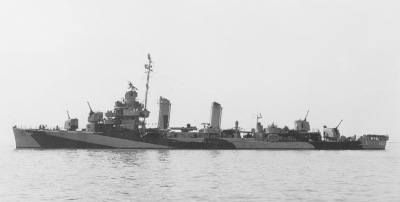 |
The USS Frazier, DD-607, a Benson-Class destroyer, my home for almost 2 years. It was built at the Bethlehem Shipyards in San Francisco, and launched March 17, 1942. |
There is an excellent WWII combat history of my ship, the Frazier, at this Internet URL.
https://en.wikipedia.org/wiki/USS_Frazier_(DD-607)
Here is a brief summary of our part in the WWII Pacific Theatre. Starting in December 1942, we were in the escort for a group of troop transports, where we served on patrol in the Solomon Islands. We saw action in the Guadalcanal campaign, in the region known as "The Slot," as the Japanese navy resupplied their land forces by barge, covered by land-based aircraft and a powerful fleet. Incidentally, this was the same region where President John Kennedy was skippering his PT Torpedo Boat, and was rammed by a Japanese destroyer. He endured serious injury, and with heroic action, he saved his crew, towing them to a nearby island, and swam to get help from one of the intrepid "coast watchers" who lived in the jungle, avoided Japanese contact, and had radio contact with our fleet.
On March, 1943, we were bound for Pearl Harbor and a rendezvous with a task force assigned to operate in the Aleutian Islands. We provided cover for the US landings on Attu, Alaska, and patrolled off that island and Kiska. We had multiple actions against Japanese submarines.
In September, 1943, we began a brief overhaul at Puget Sound, Washington. I was then detached from the Frazier and ordered for duty in Florida, on the USS Edsall, where I served various duties, including a brief stint in Washington, DC. Eventually, I mustered out of the Navy in December, 1945.
Although it was just a year and a half, I lived a lifetime in that destroyer service. The paragraphs above tell the story of our combat, but there were many personal stories as well. Every sailor had his own stories. To fight effectively, the entire crew had to operate as a single team. In my case, my Sonar equipment was located in a tiny room located just off the bridge. There was a door between my post and the operational deck where the skipper made crucial decisions. As I was to experience later, the fact that I was close to the Officer of the Deck, making split-second decisions, was going to offer me a 50-yard-line seat in the action of the entire ship.
One early event which demonstrated the urgent need to get our activities honed up, happened as we first sailed out of the Golden Gate, headed for war, about a day out of San Francisco. We were in full training mode, so that when my sonar display located a large target, perhaps a Japanese sub, orders immediately went to the depth charge crew, with distance and direction orders. On this day, we really didn't expect Japanese submarines close to our shores, and yet, rumors abounded about the audacity of the Japanese to destroy Pearl Harbor. They could certainly have sent submarines to do damage to our coastal cities and industry.
And, there it was-a big target ultrasonic return on my Sonar system display. We weren't fooling around, and our Captain, assured that this was NOT an American sub, undoubtedly from some secret operational documents he had. So off went the depth charges.
How did we do? A large dead whale floated on the surface. Obviously, I had more things to learn about the SHAPE of the ultrasound returns and plots. Steel submarines have sharp edges on the images, while soft targets, even large ones like whales, have soft fuzzy edges. Luckily, the skipper judged that we did the right thing, it was good training for the entire team of inter-related systems. And we steamed on, out into the Pacific, to join the war.
On another occasion, our ship was just one of maybe 20-30 ships, in a major convoy armada. In such maneuvers, when there are submarine threats, the entire convoy executes fast evasive turns at random times. There are years of Naval experience on how orders are given for those changes in speed or direction, from the Commodore's flagship. It is especially dangerous when there is radio silence, and orders are given by flag signals or shuttered lights between ships. Imagine the difficulty in getting EVERY ship synchronized for execution of the turn at the ordered time.
In this case, our destroyer was sailing close to a large carrier. The order came for a turn in direction, and somehow our ship didn't get the precise order to start the turn. I mentioned earlier that my Sonar room was right adjacent to the bridge, and I can remember the confusion which was starting as the lookouts out on the deck realized that rest of the convoy was turning, AND WE WEREN'T. I was able to hear the skipper order the seaman at the helm to stand aside, as he took over and spun the wheel in the right direction. He ordered the engine room to take some immediate action to get both propellers going in the proper direction.
As I stepped out of my Sonar room, and looked out the window, all I could see in that direction was that the ENTIRE window was full of a great grey WALL-which was the side of the carrier. We were SO close. I credit the Captain with an exceptional performance in avoiding a serious ship collision. He seemed to know precisely what orders to give and just how to combine the steering and engines' speed and direction. When a ship makes a sharp turn, it doesn't follow in a path of water, but instead tends to turn around its center of gravity.
The Captain was able to predict what the ship was going to do, and to avoid a very dramatic collision, which would have been dangerous for all concerned.
Hiring on to Hewlett-Packard
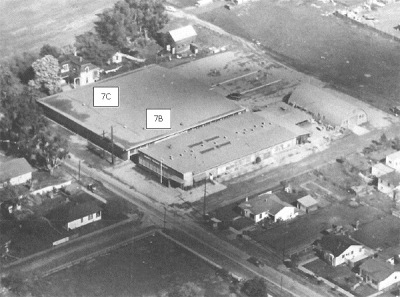 |
When I hired on during 1948, I worked in the new "concrete" buildings 7B and 7C, which had just been constructed adjacent to the Redwood building (middle of picture). The WWII Quonset building is upper right. |
After leaving the Navy, I returned to San Francisco. But I soon decided to enroll in an electronic trade school to build on my Navy work. It was the Capitol Radio Engineering Institute, in Washington, DC. About 2 years later, I graduated with my specialized training, and moved back to San Francisco.
I had heard about Hewlett Packard during my training at Capitol, and we used a few of HP's simple instruments in our radio training. We had heard from some experienced people that HP equipment was known for reliability and performance.
Because I was still living in San Francisco, I drove down to Palo Alto and HP, for a non-scheduled interview. My principle interviewer was George Blanchard, with others. One of the questions asked was, "Do you play baseball?" This told me the kind of place HP was. Then, after the interviews, I was offered a job, and started work at HP in April, 1948.
With this important new job, I needed to find a place to live. I asked for recommendations from other HP people, and soon found a room for rent, in a house at 2550 Ramona St., just across the Southern Pacific railroad tracks, and only 3 blocks from the HP plant which was on Page Mill, near Alma Street.
Meeting Olive
 |
Olive and I were married in August of 1953, in the Calvary Presbyterian Church in San Francisco. |
Olive Bliss was born on Long Island, NY, and her family moved when she was a youngster to the Marina District in San Francisco. She graduated from Lowell High School, and then San Francisco State, and became a school teacher. She loved teaching, and taught in elementary schools for the Palo Alto School District for 30 years.
Olive and I met in an informal gathering at a friend's home, after I was already working for HP. We found that we shared many common interests, including classical music, climbing and hiking, travel, and many other activities. We were married at Calvary Presbyterian Church in San Francisco in 1953.
My HP Job Experiences
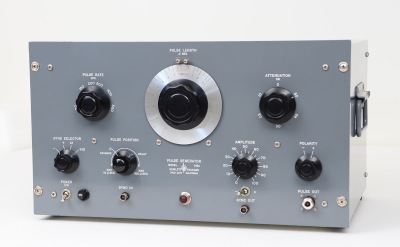 |
Bill Hewlett showed me how the thyratron tubes in this HP 212A needed to run hot to keep the internal gases at the proper temperature. |
My first job at HP was on the Test Line. It was managed by George Blanchard, although my immediate boss was Hal Dugan. The test line is a great entry into electronics production, you get to understand test procedures, use multiple pieces of test equipment, and learn the protocols of trouble shooting.
One of the instruments I tested was the HP 212A pulse generator. It was an important product for testing on systems like radars. It had an exceptional 50 Volt output, and was based on high power capacity electronic tubes called thyratrons. It had a clever pulse-shaping design which used the first thyratron to launch a traveling wavefront down an unterminated coaxial transmission line. The round-trip speed of the pulse wavefront was 10 microseconds. To provide shorter pulse widths, with the front panel pulse-width control, the second thyratron would trigger to short out the wave at the desired width. But one of the limitations of the thyratron tube was that its internal hydrogen gas required that it run hot for proper performance.
Usually the instrument production went smoothly, but at times there were problems with the shape of the pulse. Instead of sharp rise and fall times, the top would be ragged looking and fail to meet specifications. My normal troubleshooting solution would be to go to the boxful of tubes and replace them until they worked. The engineer on the instrument, George Kan, would come by occasionally and listen to my pleas to help figure what was wrong, since it seemed to me to be more than just chance that some worked well and others didn't.
One day, Bill Hewlett showed up, standing behind me and watching me, while I was frustrated with an uncooperative batch of instruments. He thought for a bit, and asked if I had a piece of cardboard handy. I found my timecard, and he inserted it between the cooling fan at the rear, and the thyratron. Suddenly, the pulse shape on the oscilloscope came up perfect, somehow affected by cutting off the cooling air. Bill explained that the internal gas needed to be hot for proper operation.
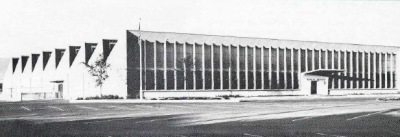 |
The corporate headquarters of the 1950 period was Building 8, at the corner of Page Mill Rd. and Park Blvd. This was the first of the HP stylized "sawtooth roof" buildings, later used on the 6 buildings in Stanford Industrial Park on the hilltop. |
Just like that, Bill showed his analytical ability, and his helpful and friendly personality. The ultimate fix, coming from that encounter, was to fabricate high temperature fiberglass "socks" that slipped down over the glass envelope, and prevented the cooling air from degrading the pulse shape.
This experience with Bill Hewlett taught me just what humane men the two of them were. They were down to earth, friendly, humorous. Yet, as leaders, they established the current thinking of management principles, by developing practices that came to be called The HP Way.
A Variety of Jobs
 |
I liked the challenge of writing Instruction Manuals for our superior HP products. This publication supported a militarized oscilloscope contract, and gave a repair technician on Navy shipboard all the circuitry and diagnostic guidance I could deduce from the scope's circuit design engineers. |
In my long HP career, I moved through a variety of jobs. After the production test period, I spent quite a lot of years in Customer Service. One of HP's most distinguishing brand images was that we thought a lot about instrument support at the customer workbench, years after the product was purchased. Each product had a comprehensive instruction manual written, which provided the service department in the customer plant all they needed to do their own annual calibration test procedures. When the product failed functionally, the manual contained circuit diagrams of all the wiring and electronic components, such as vacuum tubes, resistors and capacitors, listed with values. The customer service tech could either get a replacement from their own stockroom, or order and quickly get a new unique part shipped from HP.
The manuals contained an overview of the instrument technology, often detailed measurement theory, connection diagrams, and step-by-step applications instructions. It gave procedures for calibrating the accuracy, which for military or aerospace companies, had to be done once a year, to preserve a measurement trail back to the US National Bureau of Standards. One volt measured at our factory had to equal exactly one volt measured on a missile at the Army's Redstone Arsenal in Alabama.
We backed up these strategies with in-depth technical training for technicians, so they could specialize on different functional technologies, such as RF and microwave. Some of the courses were held in Palo Alto, and others were held in cities with HP Field Offices in their Service Departments. Often the HP Field Service Techs traveled to Palo Alto for training and team building. When you got a company-paid air trip to headquarters, you knew that you counted and were a valuable member of the HP team. The Field office Service Dept would often bring in customer technicians to train them on their benches.
I did instructional manual writing as well as training. In the early days, I helped organize some of the Field Road Shows where a given Regional Field Office would load up a number of company station wagons, and drive to various cities for local measurement demonstrations. These events provided valuable selling opportunities, which came under the title of a Measurement School.
I spent some years in the Material Engineering Group, managed by Larry Johnson. This group was responsible for purchasing the most reliable components, such as vacuum tubes, and later transistors and then integrated circuits, by the billions. Since they negotiated contracts for ALL of HP divisions scattered around the globe, they could dangle huge purchase quantities in front of the supplier salesman and his management. The engineers specialized, one an expert on passive components, another on integrated circuits, another on transformers or RF components. We worked with design engineers in the product divisions to make technical decisions on new components that were needed for our newest instruments.
Part 2, My Causes, Hobbies and Passions
The Monterey Bay Aquarium
 |
The Monterey Bay Aquarium is a world-class visitor destination, research and teaching institution. It was created in the Knut Hovden cannery, which closed in 1973, due to the collapse of the sardine fishery. Photo Courtesy of the Monterey Bay Aquarium |
Dave and Lucile Packard created the Monterey Bay Aquarium, which opened in April, 1984. As a WWII US Navy man, I loved the ocean and its environment. The aquarium was a new concept in public education, although Packard and his Marine Science team made sure that they studied previous and current aquarium operations across the United States. I recall in particular that they carefully studied the Baltimore Aquarium, which had revitalized the downtown City of Baltimore, and set new standards for research and education and public interest, especially for children.
The Phase 1 construction project came in at $55 million dollars. Packard hoped for widespread interest in this new venue, so they offered lifetime memberships to the aquarium to HP employee families for a one-time $250 fee. This drew a surprisingly large number of early HP members. The Packards also made a strategic decision to form a volunteer group of interested people, who were envisioned to take on roles of hosts and guides, and even some of the volunteers putting on wet suits and cleaning the inside of the windows on the big wave tank, with 20 foot high windows. Others were presenters at exhibits like the Penguin show. In later years, the volunteer organization grew to over 1000 people.
You can imagine the complexity of rolling out a facility like this, with hundreds of pumps and water conditioners and temperature controls and fish-feeding routines in the technical side of the aquarium. Of course, mini-computers, like those made by HP were already taking on automation duties in industry, so many of the critical tank processes were computerized as soon as possible. On the people side, there were many administration projects to computerize, needing software programs to be installed. These ranged from membership data functions, to visitor reservations, to financial systems, etc. All of the technical and administrative people needed email-style communications. This was in the late 1980's, well before the Internet grew up everywhere. Fortunately, the Hewlett Packard Company was already operating its own INTERNAL email communications systems.
So I began my decades-long commitment to the aquarium. I did all kinds of jobs that needed doing. Luckily, Olive's parents had retired down near Monterey, so I was able to go for several days when needed at the aquarium, maybe pipes needed a clean out or needed repair. Being technical, with a lot of experience in HP's technical publications, I was asked to begin documenting the dozens of various technical systems. They were another version of my HP instruction manual writing process. These instructions served in the training of the many new employees and volunteers who needed to operate them or troubleshoot those automated processes. When you have a huge tank full of vulnerable (and valuable) marine animals, and perhaps the temperature control fails, you can't just call the town electrician.
I was so fortunate to be in those jobs during the days after Dave Packard had retired from HP Company, and was spending a lot of time himself at the aquarium. I got to know him pretty well, and admired him for his humanity and practical common sense.
As the aquarium success grew quickly from 1984, Packard could see the need for a technology-driven research arm to study the ocean as its environment changed. So he created the Monterey Bay Aquarium Research Institute (MBARI). MBARI is a private, non-profit oceanographic research center located in Moss Landing, California, a dozen miles north of Monterey. It was founded in 1987 and is primarily funded by the David and Lucile Packard Foundation.
I soon found that volunteering for projects at MBARI was especially interesting because these involved equipment designs that were unique. For example, they took on deep-diving submersibles which operated under remote control, in conditions that were breathtaking. They were able to do research at depths which revealed marine science and marine animal species that were unique. I was able to work with world-class scientists and experts. With my photography background, I became the major one to document all the steps of the construction process at MBARI.
In my volunteer years, I got to know Dave's daughter, Julie Packard. She took on the leadership role for the entire operation, Chairwoman of the Board, and CEO of the aquarium. Like her father, Julie was a real winner as a leader. She was responsible for fund raising, city relations, and the very large team that made the aquarium a visitor-wonder every day. She was also great at cheerleading the very large volunteer staff.
Galapagos Island, 1970
Click HERE to read my full Galapagos report
In 1970, I signed up for a sailing tour of the Galapagos Islands, in the company of 30 other members of California's Sierra Club. We flew to Balboa, Panama and boarded our home for the next weeks, the "Te Vega," a 156-foot gaff-rigged schooner. This was not a trivial cruise, the Galapagos destination was over 1000 miles out in the Pacific from Panama. This was long before the Islands became a popular destination.
 |
For a WWII Navy man, our schooner cruise to the Galapagos Islands was an absolute delight. My story of the trip was published by HP's employee newsletter, Reporter, in 1970. |
My US Navy experience was 2.5 decades before, but I loved being back on the ocean. I looked forward to the unique nature of those islands which are part of our philosophical culture from the years of Charles Darwin and his ideas of evolution that sprang from his own visit to the Galapagos on the British ship Beagle.
Our visits to the islands themselves were stunning, seeing unique creatures which developed from the isolation of those islands. We scuba-dived in 75-degree water, with exceptional visibility. We had several experts along in our group who tutored us on these unique names of fish and creatures of all kinds. In my article referenced above, I conclude my HP WATTS CURRENT newsletter report with the lines, "Darwin's inquisitive mind needed the simplicity and isolation of the Galapagos to clearly demonstrate the development of species that he described 25 years later in his famous paper, "The Origin of Species." For a moment, we shared in that same, never-to-be-forgotten wonderment!"
Mountain Climbing
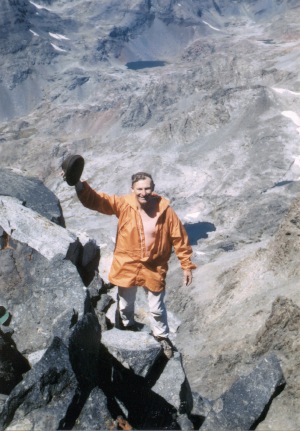 |
For all of my life, I found fulfillment in trail hiking and mountain climbing. Even better, Olive accompanied me on many of our adventures. |
Living in California increases the chances that you will become addicted to mountains. California has mountains in abundance, from the majestic Sierra range on the East and the Coastal ranges all along the ocean. Then more unique mountains in the very South around San Diego and Palm Springs and also the far North near the Oregon border.
I caught the mountain climbing bug early, and fortunately I was able to share that passion with Olive, and with many other friends, often with HP visitors. I did both hiking and mountain peak climbing, and rock climbing. I once made a list of all the peaks we had climbed, and it numbered around 20. This included Mount Whitney, the highest mountain in the contiguous US, and many Yosemite high peaks. Olive shared many of our climbs, with great enthusiasm. Together we hiked and climbed in Switzerland, Norway and Germany.
We would often invite HP visitors such as International Field Salesmen to join us in the Sierras, as they relaxed from their seminars and management meetings at HP.
The Josiah Dwight Whitney Centennial Memorial Mountaintop Signaling Project
Click HERE to read John Hoyte's full Whitney Centennial Mountaintop signaling project in Chapter 12 of his unpublished manuscript.
Click HERE to access Hoyte's interesting website, with story and more pictures: http://johnhoyte.com/high-sierras/
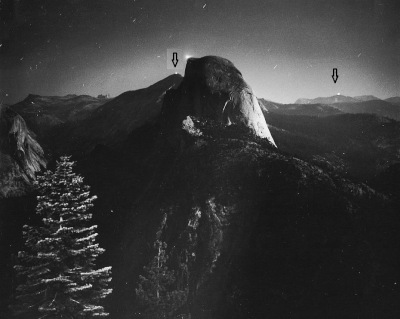 |
Flares on Mount Lyall, Clouds Rest and Half Dome, with a full moon above. Look carefully (arrows) for the dim flares on the two mountains behind Half Dome. Photo Courtesy of John Hoyte. |
Back in 1863, Professor Josiah Dwight Whitney had been asked to make a complete land survey of California for the state. Mount Whitney, the highest peak in the contiguous United States, is named after him. The team must have been great mountaineers as well as surveyors for they were the first known climbers to scale the highest peaks in the Sierras.
John Hoyte was a friend of mine who worked at HP for maybe 6 years. John worked on one key project, the Quartz crystal precision thermometer. He left HP to start a small company called Spectrex, which developed a novel spectroscope in Menlo Park, patented by his 92-year-old uncle. Hoyte was a wartime prisoner of the Japanese in China, since his parents were missionaries, and were caught in WWII. He was a master of many interests, and one of the most unusual, was to organize and fund a project to re-create the legend of Hannibal's journey over the Swiss Alps, with a real elephant and entourage. While Hannibal was said to have made the trip with 37 elephants, Hoyte retraced the trip with a single elephant.
Hoyte and I and several others had set a challenge to ourselves to scale a different Sierra peak each year. In 1962, on the top of Mount Hoffman (Hoffman was on Whitney's original survey team) we realized that in just a year, it would be the 100th anniversary of Whitney's feat. As we considered various ways to celebrate the centennial, it occurred to us that we could arrange a flare signaling sequence of mountain peaks all the way from Mt. Whitney to Yosemite National Park, a distance of about 115 miles. The project took the title of The High Sierra Centennial Climb.
We began to solicit our Sierra Club membership, to recruit climbers for the unusual event, who would be formed into 20 climb teams. The plan was to have all teams on their respective peaks at a prescribed 9:00 pm time, and to start the flare signal at Mt. Whitney, and every 1.5 minutes later, the next peak would light their flare signal. All of the 20 peaks were not a straight line, but we determined the highest peaks along the way, generally following the John Muir Trail along the high ridge regions. Each team would watch for a flare from the southern direction, and then light off their own flares, one peak after another. So within 30 minutes, 20 flares were lit across the ridgeline of the Sierras, all in darkness after sunset.
Olive's father and I were involved in the logistical planning, and we had to find a fireworks vendor for legal flare pyrotechnic devices. It was a successful project, especially for all of the participants. The enthusiasm of mountain oriented people can be catching. I don't recall much publicity of the whole thing, but all of our peak climbers felt a satisfaction of a unique event.
My Experiences with Fred Schroder and Others
Click HERE to read my informal notes of various shared activities when Fred visited the Bay Area, and later when he moved here.
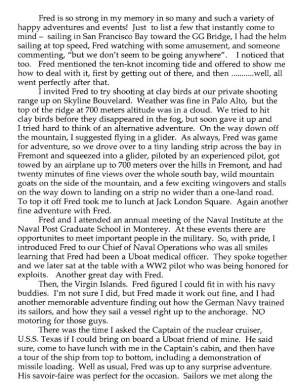 |
My notes on activities with Fred Schroder, who was General Manager for HP's European company. See Text for Click Reference. |
Click HERE to read a letter Fred wrote in 1996 to Karen Lewis, former Corporate Archivist at HP, to reveal some his personal observations and experiences with Dave Packard.
One of the finest attributes of working at Hewlett-Packard was the constant stream of visitors from our Sales Offices around the world. This company grew into almost every nation on earth, and when the managers traveled to Corporate Headquarters, for training or management meetings, they brought their nation's culture with them. And in turn, they captured the US social culture, and especially that special culture that Dave and Bill built, called The HP Way.
We in the HP Marketing groups hosted these personnel, and gladly shared with them our own enthusiasm for the work culture that worked so well for us, intending that they would bring it to their own HP country teams. Out of these numerous opportunities came many personal friendships. In my case, lifetime friendships developed with Fred Schroder of Germany and Bob Eckhardt and Arne Bernow of Sweden. Carl Cottrell recalls that Fred Schroder and Ray Demere started GmbH in 1958 in an old brick building near the railroad station. Demere returned home about 1961, and Fred became General Manager, a post he held for some years. He knew and worked directly with Bill and Dave in establishing the new plant at Boblingen.
Over the years, I developed really close friends with individuals like Schroder. As the world recovered from WWII, former enemies became friends, Germany became a close economic and political ally of the US. Fred had been the Medical Officer on a German U-boat, which operated in the Mediterranean Sea, thus developing some interesting situations as he became my friend and met various of my US Navy friends.
Fred and I shared many activities, from mountain climbing to glider flying to sailing around the Golden Gate and attending concerts. He was a delightful companion, and a good friend. (We took care of his two children several times.)
Precision Target Shooting
 |
I have seen coins with a single hole, but which had 3 successive slugs through the same hole, at 100 yards. |
I have always enjoyed the challenge and personal fulfillment of precision target shooting. I like the demanding needs of creating the ammunition that I use on the range. I also have shared the hobby with friends and many HP visitors from many countries. We used a target range up along Skyline in the coastal range above Palo Alto.
Other Life Hobbies and Passions
Classical Music. As a naturally curious person, with a technical mind, I have developed quite a variety of hobbies and interests. All my life I have been a classical music fan. My mother was a fine pianist and I grew up listening to my mother playing classical works. I had other music interests too, in 1973, Olive and I went on a pipe organ tour in East Germany.
Railroads. I was always captivated with vintage railroad technology, visiting the Railroad Museum in Sacramento, and taking many organized tours on steam engines and trains in the Western states. Olive and I belonged to several organizations which supported old steam trains. We took one train ride between Reno and Elko and back, with many stops at good scenery, so we could all get out for picture-taking. Once I even got to be in the engineer's seat as the train moved around the yard at Portola.
Photography. I grew up in a family of photographers. In my early years I had a home darkroom. Although prizing my traditional camera equipment, when the photo world went digital, I went with it, and loved the power of digital cameras and the capability they lent our travel adventures.
Sports. In addition to climbing and sailing, I enjoyed tennis and scuba diving. We often attended sports events at Stanford and in San Francisco.
Gardening. I found gardening relaxing and challenging. You can grow almost anything in California, but to get good at it, you have to pay attention and be prepared to learn proper procedures. I cultivated a rose garden and a cactus garden.
US Navy League
I joined the local chapter of the Navy League. They held regular local meetings, which gave us many opportunities to listen to the Navy viewpoint of current national and global politics. On one occasion, I invited Fred Schroder to an annual meeting of the Naval Institute, held at the Naval Post-Graduate School in Monterey. At these events, there were usually very important retired Navy personnel, who often retired in Monterey. I was able to introduce former German Naval Submarine Medical Officer (Fred) to our US Chief of Naval Operations. They easily discussed subjects like personnel training and operational matters, like fleet communications.
The Navy League publications contain interesting articles about strategic considerations of the current fleet capabilities, and future analyses of our military posture. I liked that kind of reading matter.
Life after HP
My life during my HP years was challenging and technologically interesting, and the friendships I made were enduring, and this continued even after my retirement. My Navy duty and my HP career involved quite a lot of travel, and my hobbies and deep interests, included global travel with Olive, for wonderful excursions, Germany, Switzerland and Sweden especially. In most of our trips, we reconnected with local people, whom we knew from the HP connections, and they treated us like family. Fred Schroder and his family entertained us like relatives, in Germany and later, Geneva, and Bob Eckhardt and his family in Frankfurt. We were able to entertain them when they came to California.
I continued personal connections with friends like Larry Johnson and Bob DeVries, who were associates in the Oscilloscope Division. We met once or twice a month for informal breakfasts, with the natural urge to share our lives and experiences all over again.
My memories of those HP years are rich and full. To close out my memories here, Olive found several old stories of my 30th year award luncheon and the 35th, from HP newsletters we saved. Every year, anniversary employees for 15, 20, 25, 35 and 40-years, would show up in suit and tie, or for the women, business dresses. They would drive down to Rickey's or other local restaurant for a nice lunch, a short speech by Dave or Bill or later, John Young. Everyone was called to the podium, the men were presented with a diamond tie clip, and the women a diamond broach pin, one diamond for each 10 years of service.
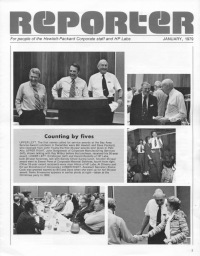

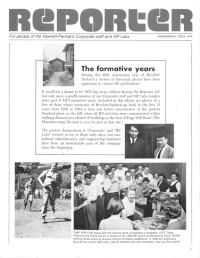
I have also shown here a remembrance issue of the Corporate Division newsletter, on the occasion of the 40th Anniversary of the company, in 1979. There are a lot of good historical photos and stories of the early days of HP.
To read any of these documents in full, just CLICK on the image.
Finally, I want to recognize, for all of you readers, my lifelong love affair with Olive. We have been together for 63 years, both in spirit and in travel and in hobbies. It has been a fulfilling and wonderful trip through all of my 95 years. I would not have wanted it any other way.
Editor's Note: John died just after his 95th birthday, in the Palo Alto Veterans Hospital on Dec 6, 2015.
Part 3, Obituary
JOHN B. BORGSTEADTOctober 31, 1920 — December 6, 2015 John Borgsteadt, a resident of Palo Alto, California, died at the Palo Alto Veterans Hospital on December 6, 2015, after a short illness. He was 95 years old. His wife, Olive, was at his side. Borgsteadt was born in St. Louis, Missouri, and moved to San Francisco's Sunset District after his father's death. He graduated from Polytechnic High School, and was an electrical repairman before his enlistment in the U.S. Navy in February, 1942. He was trained as a Sonarman (now called Sonar Technician), and saw duty on a destroyer, first deployed to combat in the Solomon Islands. They saw action in the Guadalcanal campaign, in the region known as "The Slot", as the Japanese navy resupplied their land forces by barge, covered by land-based aircraft and a powerful fleet. His ship was later ordered to the Alaska theatre. Discharged in 1945, John enrolled in the Capitol Radio Engineering Institute in Washington, DC. Upon his return to the Bay Area, he joined the Hewlett-Packard Company in 1948. Through the decades, he worked in the test department, and later, in technical publications and customer service. He delighted in meeting visitors and customers from other countries and showing them the Bay Area and sometimes the Sierra. He married Olive Bliss in 1952. John retired in 1993, after a long career at H-P. He liked remembering his decades-Iong experiences in a company that grew from 150 employees, when he was hired, to a global giant. An abiding passion was volunteer work at the Monterey Bay Aquarium and its research affiliate, the MBA Research Institute (MBARI). He took on numerous jobs, such as writing instruction manuals for the maintenance procedures needed in the daily operation of tanks and water treatment processes. He helped organize visitor activities and receptions, such as when the Keldych, a Russian marine research vessel, visited the US West Coast for the first time. John's hobbies and passions spanned a stunning diversity of interests. He was a classical music aficionado, often taking guest visitors to S.F. cultural events and sometimes going backstage to speak with the musicians. He was a gifted photographer and developed his own pictures (in the early days.) He enjoyed scuba diving and sailing. He was a precision target shooter, often inviting guests with similar interest to compete. A life-long activity was hiking and climbing in the Sierra and in Switzerland. John lived in Palo Alto, CA with his wife of 63 years. No memorial services are planned. Remembrance donations may be made to Second Harvest Food Bank. |
HP MemoriesOne of the main objectives in starting this website five years ago was (and still is today) to get in touch with people who have worked at hp from the birth of the company up to today. We are interested in hearing your memories no matter what division or country you worked in, or whether you were in engineering, marketing, finance, administration, or worked in a factory. This is because all of you have contributed to the story of this unique and successful enterprise. Your memories are treasure for this website. While product and technology are our main concern, other writings related to the company life are highly welcome, as far as they stay inside the hp Way guidelines. Anybody Else? Please get in touch by emailing the webmaster on the Contact US link at http://www.hpmemoryproject.org |
|
|
